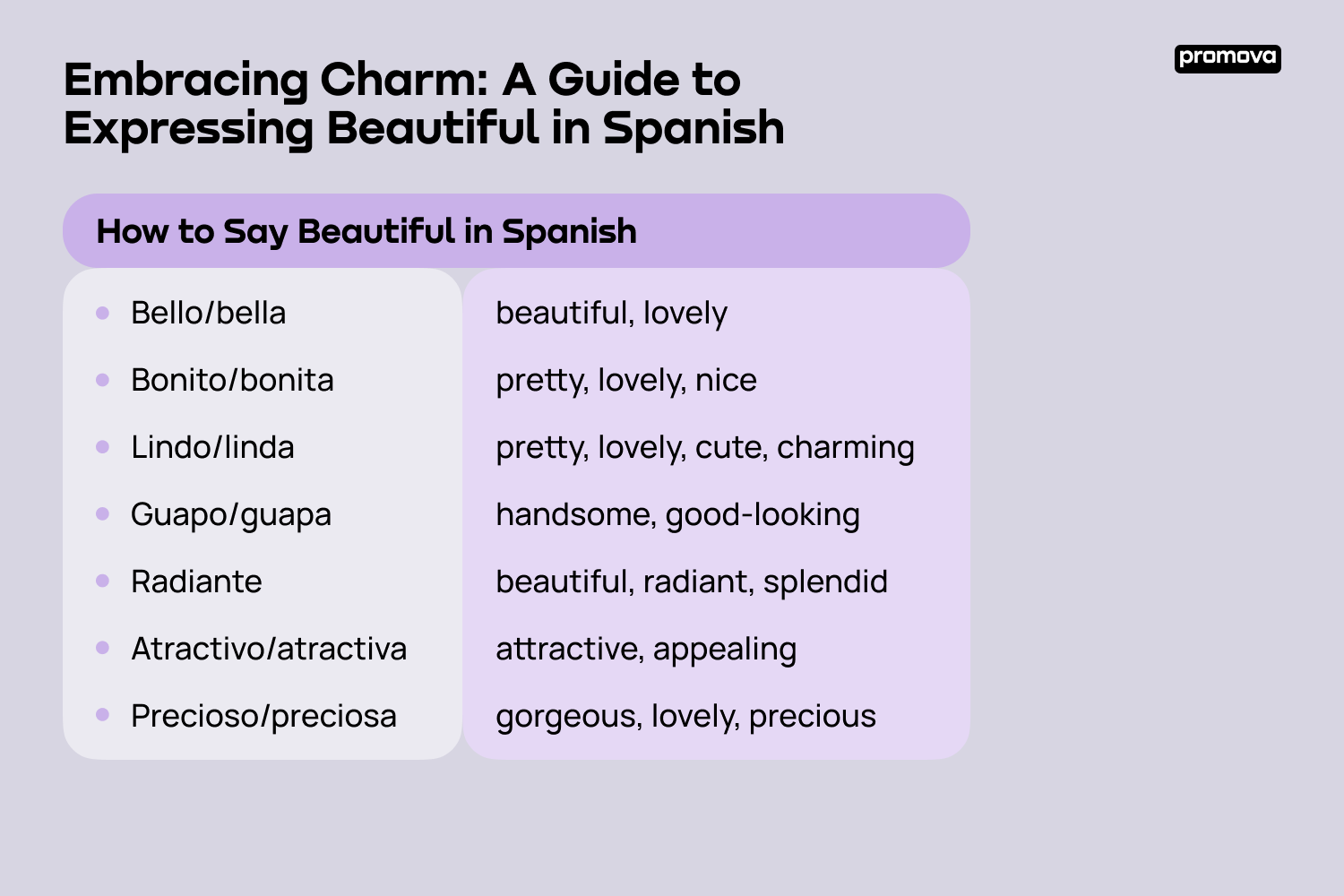Embracing Charm: A Guide to Expressing Beautiful in Spanish


You will get a promo code with a discount for our app courses after reading this article.
Contents
Margaret Wolfe Hungerford once said: “Beauty’s in the eye of the beholder.” This timeless adage resonates across cultures, underscoring the deeply personal and subjective nature of what we perceive as beautiful. After all, you can find something lovely, pleasant, or attractive anywhere you look. In today’s article, we will talk about saying beautiful in Spanish.
This charming language has many adjectives that describe people, places, nature, art, and other things. So buckle up, and let’s find out the meaning of the Spanish word hermoso and its wonderful synonyms and alternatives.
Hermoso/a: Main Spanish Word for Beautiful
When it comes to expressing beauty in Spanish, one word that stands out prominently is hermoso (masculine) and its feminine counterpart, hermosa. These terms encapsulate the essence of beauty and are often the go-to choices when describing external attractiveness and other forms of beauty that go beyond the surface. Both hermoso and hermosa in English mean “beautiful,” and just like this word, they can be used to showcase various things. Here are some common examples:
- Physical Appearance
Ella es una mujer hermosa. (She is a beautiful woman.)
El vestido que llevas es realmente hermoso. (The dress you’re wearing is truly beautiful.)
- Nature and Scenery
El paisaje montañoso es simplemente hermoso. (The mountainous landscape is simply beautiful.)
El jardín está lleno de flores hermosas. (The garden is filled with beautiful flowers.)
- Art and Creativity
La pintura en el museo es una obra maestra hermosa. (The painting in the museum is a beautiful masterpiece.)
La música de esta banda es realmente hermosa. (The music of this band is truly beautiful.)
- Experiences and Emotions
Fue un día hermoso en la playa. (It was a beautiful day at the beach.)
Su discurso inspirador fue realmente hermoso. (His inspiring speech was truly beautiful.)
The origins of hermosa meaning can be traced to the Latin word formosus, which also means beautiful. Latin was the precursor to many modern Romance languages, including Spanish. This root word provided the foundation upon which hermoso was built. Nowadays, it is the most popular adjective describing attractiveness in Spanish-speaking countries.
How to Say Beautiful in Spanish: Alternative Expressions and Synonyms
While hermoso and hermosa are the primary words for beautiful in Spanish, the language offers a vibrant array of synonyms and alternative expressions to add nuance and diversity to your vocabulary. From romantic descriptions of a loved one to awe-inspiring landscapes, these alternatives allow you to tailor your expression of beauty to various contexts. Here are some synonyms for beautiful in Spanish and ways of using them in sentences.
- Bello/bella – beautiful, lovely.
El arte en este museo es realmente bello. (The art in this museum is truly beautiful.)
Ella tiene una sonrisa bellísima. (She has a very beautiful smile.)
- Bonito/bonita – pretty, lovely, nice.
El parque tiene un lago bonito donde la gente pasea. (The park has a beautiful lake where people stroll.)
Compré un vestido bonito para la ocasión especial. (I bought a pretty dress for the special occasion.)
- Lindo/linda – pretty, lovely, cute, charming.
El bebé tiene una sonrisa linda que ilumina la habitación. (The baby has a cute smile that lights up the room.)
El pueblo tiene calles estrechas y casas lindas de colores. (The village has narrow streets and charming, colorful houses.)
- Guapo/guapa – handsome, good-looking (mostly used to describe people).
Mi hermano es guapo y siempre recibe muchos cumplidos. (My brother is handsome and always receives many compliments.)
El actor principal de la película es muy guapo y talentoso. (The main actor in the movie is very handsome and talented.)
- Radiante – beautiful, radiant, splendid.
La novia caminó hacia el altar luciendo radiante en su vestido blanco. (The bride walked down the aisle looking radiant in her white dress.)
El sol poniente creó un cielo radiante de colores cálidos. (The setting sun created a radiant sky with warm colors.)
- Atractivo/atractiva – attractive, appealing.
El nuevo profesor de la universidad es muy atractivo y carismático. (The new professor at the university is very attractive and charismatic.)
El diseño del edificio es moderno y atractivo para los visitantes. (The building’s design is modern and appealing to visitors.)
- Precioso/preciosa – gorgeous, lovely, precious.
El regalo que recibí era un collar precioso con un diamanté. (The gift I received was a precious necklace with a diamond.)
La vista desde la montaña es preciosa, con un mar de nubes al horizonte. (The view from the mountain is gorgeous, with a sea of clouds on the horizon.)

Beautiful in the Spanish Language: Describing Places and Things
The words provided above can be used to describe the beauty of both people and inanimate objects. Yet, some adjectives in this language are only suitable for specific contexts. Here are some different ways to say beautiful in Spanish when describing places and things.
- Pintoresco/pintoresca – picturesque.
El pueblo es pintoresco, con calles empedradas y casas de colores. (The village is picturesque, with cobblestone streets and colorful houses.)
El cuadro captura un paisaje pintoresco. (The painting captures a picturesque landscape.)
- Majestuoso/majestuosa – majestic.
La montaña es majestuosa, con picos cubiertos de nieve. (The mountain is majestic, with snow-covered peaks.)
El reloj de la abuela tiene un diseño majestuoso. (The grandmother’s clock has a majestic design.)
- Espléndido/espléndida – beautiful, splendid.
La vista desde la cima de la montaña es espléndida, con valles verdes extendiéndose a lo lejos. (The view from the mountain top is splendid, with green valleys stretching into the distance.)
El palacio real exhibe una arquitectura espléndida que refleja la grandeza de la historia. (The royal palace showcases splendid architecture that reflects the grandeur of history.)
- Magnífico/magnífica – wonderful, magnificent.
El teatro antiguo tiene un interior magnífico con detalles ornamentados en cada rincón. (The ancient theater has a magnificent interior with ornate details in every corner.)
La puesta de sol en la playa es simplemente magnífica, pintando el cielo con tonos dorados. (The sunset at the beach is simply magnificent, painting the sky with golden hues.)
- Estupendo/estupenda – great, marvelous, fantastic, stupendous.
La exhibición de arte contemporáneo en el museo es estupenda, presentando obras innovadoras. (The contemporary art exhibition at the museum is fantastic, showcasing innovative works.)
El servicio en este restaurante es estupendo; el personal siempre está atento y amable. (The service at this restaurant is great; the staff is always attentive and friendly.)
- Agradable – pleasant, agreeable.
El clima en esta región es agradable durante todo el año, lo que lo convierte en un destino popular. (The climate in this region is pleasant year-round, making it a popular destination.)
El parque tiene senderos rodeados de vegetación, creando un ambiente agradable para pasear. (The park has trails surrounded by greenery, creating a pleasant atmosphere for strolling.)
2
Adding Emphasis to Spanish Adjectives
Have you ever seen someone or something so beautiful that you thought this simple word was not nearly enough to describe it? When it comes to expressing beauty or attractiveness in Spanish, you can enhance your descriptions by using specific intensifiers or adverbs. These linguistic tools help convey the strength of your admiration or appreciation. Here’s how you can elevate your language and add emphasis to Spanish adjectives:
- Muy – very.
Ella es muy hermosa. (She is very beautiful.)
El cuadro es muy impresionante. (The painting is very impressive.)
- Realmente – truly, really.
Su voz es realmente encantadora. (Her voice is really charming.)
El paisaje es realmente majestuoso. (The landscape is truly majestic.)
Another great way to emphasize the adjectives is to add the suffixes -íssimo and -íssima. By doing it, you will achieve the same results as by adding adverbs from the list above. Here are some common examples of intensifying Spanish words for beauty:
- Esplendíssimo/a – extremely splendid.
El vestido de gala que llevaba era espléndidisimo, con detalles brillantes que deslumbraban. (The evening gown she wore was extremely splendid, with sparkling details that dazzled.)
El palacio en el centro de la ciudad era una construcción espléndidisima que atrajo a turistas. (The palace in the city center was an extremely splendid building that attracted tourists.)
- Hermosíssimo/a – absolutely beautiful.
La flor en el jardín era hermosísima, con colores vibrantes que atraían a todos. (The flower in the garden was absolutely beautiful, with vibrant colors that attracted everyone.)
La vista desde la cima de la montaña era hermosísima. (The view from the mountaintop was absolutely beautiful.)
- Atractivíssimo/a – extremely attractive.
El modelo de automóvil deportivo era atractivísimo, con líneas aerodinámicas y un diseño elegante. (The sports car model was extremely attractive, with aerodynamic lines and an elegant design.)
El perfume tenía una fragancia atractivísima que atraía a todos a su alrededor. (The perfume had an extremely attractive fragrance that drew everyone around.)
Learning to Make Compliments in Spanish with Promova
As you can see, even such a simple, at first glance, word as “beautiful” has numerous alternatives in Spanish; we probably don’t even have so many different hermosas in English. Memorizing them all alongside other essential terms can be challenging regardless of your fluency level. Installing a convenient application is an effective and convenient way to learn new words and grammar. Luckily, we know where to find one and are happy to introduce you to Promova.
After installing the Promova app on your iOS or Android device, you need to pass a quick test to determine your fluency level. It will help to create a personalized plan based on your skills and needs. When it’s done, you can access over a hundred lessons, quizzes, and other helpful materials.
The primary goal of our app is to make your studying process as simple, engaging, and useful as possible. That is why the Promova app provides many studying methods, including flashcards, illustrations, listening exercises, interactive quizzes, and other fun activities created by experts. You can easily track your progress and effectively practice essential language skills. So what are you waiting for? Install the Promova application today, and get handy access to useful tools and materials for learning languages.
Conclusion
Beauty, in all its captivating forms, is a concept that transcends language and culture. From the delicate intricacies of nature’s canvas to the artistic expressions of human creativity, the ability to express beauty in words is a bridge to a deeper understanding of the world around us. In today’s article, we’ve done our best to provide you with numerous Spanish words that will help you describe all the beautiful things, places, and people you see. By the way, what does hermosa mean in your native language? Let us know in the comments section!
Use your discount and learn languages with Promova
Start learningFAQ
Are there any regional variations in how “beautiful” is expressed in Spanish-speaking countries?
Yes, indeed! Different Spanish-speaking countries might have their own preferred words or phrases to describe beauty. For instance, while “lindo” is commonly used in many countries, in Spain, you might hear “guapo” or “precioso” more often.
Are there any specific beauty-related phrases and idioms in Spanish?
Absolutely! Spanish offers a range of phrases that capture the beauty in various contexts. For example, the expression “una obra de arte” (a work of art) can describe something as beautiful beyond its physical appearance.
What is the difference between bonito/a, hermoso/a, and lindo/a?
While all three words generally mean “beautiful” in English, there are subtle differences. Bonito/a often conveys “pretty” or “nice,” used for describing something visually appealing. Hermoso/a leans toward “handsome” or “gorgeous,” often used for profound beauty. Lindo/a carries a sense of “lovely” or “charming,” used for something that elicits positive emotions.
How to avoid sounding repetitive when describing something or someone beautiful in Spanish?
To avoid repetition, use a variety of descriptive words, including synonyms and intensified adjectives. Mix and match different adjectives to capture various aspects of beauty, and consider focusing on other sensory details beyond visual beauty, such as sounds or textures.



Comments